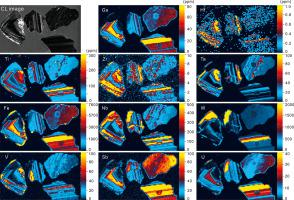Chemical Geology ( IF 3.6 ) Pub Date : 2022-08-19 , DOI: 10.1016/j.chemgeo.2022.121063 Xiaohu He , Jianxin Zhao , Renjie Zhou , Yuexing Feng , Nicole Leonard , Fei Li , Zheng Liu , Wanting Li , Shucheng Tan

|
The tetragonal lattice structure enables cassiterites to incorporate dozens of elements within their crystal lattice (e.g., Fe, Ti, W, Zr, Hf, Ta, Nb, Mn, Sc, V and Sb). Thus, it is anticipated that variations of these elements should record information of potential elemental substitution mechanisms and precipitation environments of cassiterites. With moderate amounts of U and Pb, cassiterites can be dated with U-Pb geochronology. In this study we collected cassiterite grains from six different ore types within the Gejiu tin polymetallic deposit to perform LA-ICP-MS U-Pb dating, multiple element mapping and in-situ trace element analysis. Systematic U-Pb dating of such cassiterites yielded Tera-Wasserburg lower-intercepted ages ranging from 81.91 ± 0.62 to 85.7 ± 1.4 Ma, coinciding, within their respective analytical uncertainties, with zircon U-Pb ages of regional Late-Yanshanian granitoids. Such age coincidence, combined with spatial association, suggests that tin mineralization may be genetically related to the late Cretaceous granitic magmatism. Multi-elemental mapping shows that the distribution of Nb, Ta, and Ti in the cassiterite grains correlate well with the regular oscillatory zoning patterns in Cathodoluminescence (CL) images. The relatively high Fe, Ga, Sb, W and U concentrations control the dark luminescing domains in these cassiterite grains. The systematic variations in chemical compositions suggest that trace elements such as Sc, V, Fe and Ga incorporate in cassiterites via coupled substitutions of Sc3+ + V5+ ↔ 2 (Sn, Ti)4+, Fe3+ + Ga5+ ↔ 2 (Sn, Ti)4+ and Fe3+ + OH−↔ Sn4+ + O2− or Fe3+ + H+↔ Sn4+. The covariation of redox sensitive elements such as Fe, Sb, W and U indicates that only ‘tin-granite’-type cassiterites were formed under an oxidized state whereas cassiterites from other ore types were precipitated in a reducing environment.











































 京公网安备 11010802027423号
京公网安备 11010802027423号